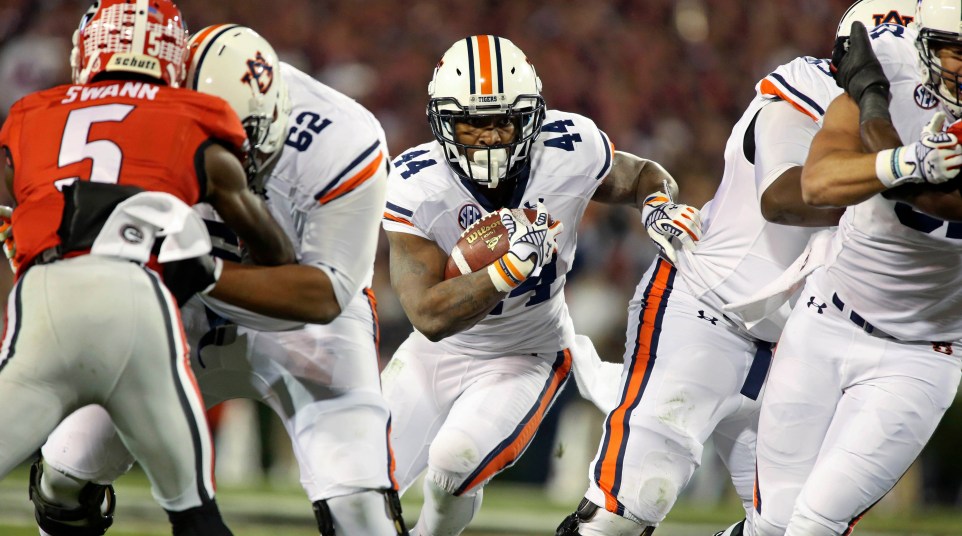Comparing Auburn, Wisconsin rushing attacks before Outback Bowl
Auburn and Wisconsin will bring two of the nation’s most potent rushing attacks with them to Tampa, Fla. when they meet in the Outback Bowl on New Year’s Day.
But just because the Tigers and Badgers both run the ball effectively doesn’t mean their offenses are anything alike.
Wisconsin was fourth in the nation in 2014 in averaging 314 rushing yards per contest. Auburn was 12th in the nation at more than 258 yards per game on the ground. Still, the two teams took completely different approaches to hit those numbers this season, and those differing styles should make for a fascinating game in Tampa.
The Tigers run the ball out of Gus Malzahn’s spread rushing attack — one of the most creative and unorthodox offenses in all of college football. Auburn ran the ball an average of 47 times per game this year, and nearly every single one of those carries came from a shotgun formation.
To the naked eye, the Tigers love to line up in what many consider to be passing formations, with a quarterback deep behind his offensive line and fast, athletic skill players flanked to both sides.
But in Malzahn’s offense that formation resembles the perfect running formation. The second-year head coach loves to send men in motion before the snap, and misdirection involving mobile quarterback Nick Marshall, the SEC’s leading rusher in tailback Cameron Artis-Payne and a receiver in motion keep opposing defenses on their toes.
Those misdirection plays force defenders to freeze and follow the ball with their eyes, and that hesitation gives Auburn’s athletes more than enough time to find a lane and follow it for a big gain.
The Tigers can attack between the tackles or around either edge, all on the same play. It’s not hard to see why defenses have struggled to stop Auburn the last two years since Malzahn arrived on the plains.
Malzahn’s offense is also predicated on making use of jet sweeps, end-arounds, reverses, double reverses and other clever run plays utilizing speed on the outside. Again, any skill player on any given play can pose a threat to an opposing defense, and again, the Tigers can attack from any side depending on what the defenses gives them.
Auburn’s speed, athleticism and unpredictability has made it as dangerous as any rushing attack in the nation, even though it operates almost exclusively out of passing formations.
Wisconsin, on the other hand, is a bit more traditional in its approach to running the football.
By now you’re likely familiar with star tailback Melvin Gordon, a Heisman finalist who ran for led the nation in rushing with more than 2,300 yards and 26 touchdowns on the year. Gordon was the Badgers’ workhorse in 2014, serving as the biggest reason for Wisconsin’s success running the football.
Wisconsin has maintained one of the best run-blocking offensive lines in the nation, dating back to Bret Bielema’s days as head coach of the Badgers. The Big Ten runners up are not quite as creative in their rushing attack, but they’re just as effective.
The Badgers are the kind of team that lines up and lets their opponent know before the snap that they’re running the ball between the tackles. Then they do exactly that, dominating helpless defenses with powerful blockers and one of the most intelligent rushers in the game today.
Gordon is patient and finds the smallest of creases better than anyone else at the college level. He’ll lower his pads and engage a defender, but has an uncanny ability to follow his blockers on any given play.
Auburn can load the box, seal off the edges and dare Wisconsin to throw the football by any means necessary. But if the 2014 season taught us anything, it’s that Wisconsin will not only run the ball anyway, but run it effectively.
Both teams are liable to amass a ton of yardage and score plenty of points this New Year’s Day. But even though their numbers may look the same at game’s end, their methods could not be more different.
Which approach to running the ball is better? We’ll find out in Tampa next week.

